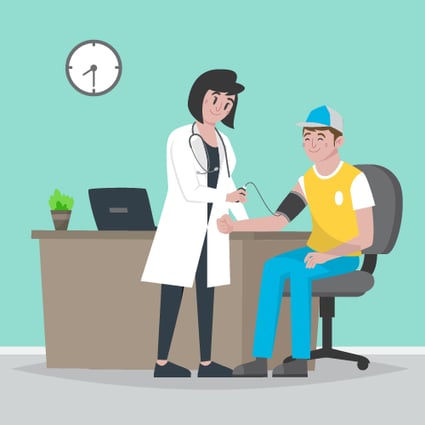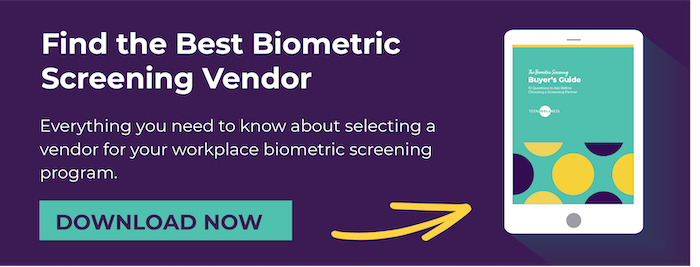 Now that it’s a new year, it’s time to consider the ways you can help your employees stay healthy all year long.
Now that it’s a new year, it’s time to consider the ways you can help your employees stay healthy all year long.
A biometric screening in the workplace is one way to do that. These screenings are one of the simplest ways employers can encourage workers to get a quick health check-up. While it can’t replace a doctor’s visit, it can provide useful insight your doc can analyze at your next visit.
If you’ve ever wondered what exactly a biometric screening covers, this post is for you.
Below, you’ll learn just what is included in a biometric screening and we’ll share data from real employees we screened last year.
What is Biometric Screening?
Biometric screenings are a series of health tests. It’s a multitude of vital statistics of a person’s health status to give them a better idea of where their health stands.
This series of tests offers a health snapshot into essential areas of your health. It also provides a great baseline or tracking method to see how your health is changing — for better or worse.
What is Included in a Biometric Screening?
Not all biometric screenings are created equal. Here at TotalWellness, our standard biometric screening service includes the following measurements:
- Total cholesterol - the total amount of cholesterol in your blood
- HDL cholesterol - this is the “good” cholesterol. High levels of HDL cholesterol can lower your risk for heart disease and stroke
- TC/HDL ratio - together, these numbers provide more details about your coronary heart disease risk
- LDL cholesterol - known as “bad” cholesterol, at high levels, LDL cholesterol raises your risk for heart disease and stroke
- Triglycerides - this is fat found in the blood. When eating, your body turns calories not used right away into triglycerides, which are stored in fat cells. Between meals, your hormones release triglycerides for energy
- Glucose - this is the main sugar in your blood that comes from the food you eat
- Blood pressure - this indicates the force of blood pushing against the walls of arteries as the heart pumps blood and shows how hard your heart is working
- Body Mass Index (BMI) - this screens for weight categories that may lead to health problems, but isn’t an indicator of individual health or fat cells.
- Waist circumference - this measures the fat around your middle. Research indicates those with thicker middles often have excess fat in their organs, too.
To go along with the biometric screening, we can also order additional testing like cotinine test (which checks for nicotine), fitness testing, and body fat screenings.
The Biometric Results Are In
Recently, we compiled all of our 2021 aggregate data for the companies that we performed biometric screening tests for across the nation.
Here is what our data showed about the health of workers who got screened:
- Total Cholesterol - Most participants were in a good spot with 71% in the optimal range
- HDL Cholesterol - For good cholesterol, 51% of participants were in the near-optimal range
- TC/HDL ratio - Of those screened, 57% were in the optimal range
- LDL cholesterol - 46% of those screened were in the optimal range; only 1% had very high, bad cholesterol
- Triglycerides - 77% of participants fell into the optimal range
- Glucose - 69% of participants were in the optimal range, meaning they were in a healthy zone and they had minimal diabetes risk
- Blood pressure - Around 40% of individuals had normal blood pressure. 32% had stage 1 high blood pressure
- Body Mass Index (BMI) - Of those tested, 25% were in the normal weight range; 33% were considered overweight and 22% had a high BMI for their height and weight range
- Waist circumference - 60% of men and women tested were in the normal range, which is less than 40 inches for men and less than 35 inches for women
Related: 10 Health Screenings to Check Off Your Health To-Do List
How Biometric Screenings Help Employees Stay Healthy
With an employee-sponsored biometric screening, your employees can’t really make the excuse that they don’t have time for health appointments — especially one as simple as this screening. Our company can bring it right to your worksite to get your wellness committee a full picture of the overall health of your team.
Plus, if employees have been worried about their blood pressure or another health issue, on-site biometric screenings are an easy way for employees to get instant results and health directives. They’ll get the answers they need straight away.
Three more reasons it helps employees with their health:
- Health goals become focused - When a specific health issue — like high blood pressure — comes up, an employee can create a game plan with their healthcare provider on how to lower it. Additionally, a broad look at employees’ health can provide essential insight to wellness committees that need to create valuable health campaigns.
- Instant results can be motivating - Blood work through a physician’s office usually takes days to get processed, including releasing results to a patient. With a biometric screening, an employee can instantly find out if they need to work on their cholesterol or blood pressure, or another health concern.
- Offers a baseline - If your employees haven’t been to the doc yet this year, a biometric screening offers a great baseline. This valuable health information can provide workers with questions they may need to ask their health provider and can prompt advocating for additional testing.
While it may be tempting to ignore health issues, that almost always ends badly. Encourage your team to stay on top of their health appointments. As an employer, consider making biometric screenings a part of your healthy lifestyle campaigns starting this year!
Have you ever had a workplace biometric screening done? How did it go? Share your experience in the comments below!



